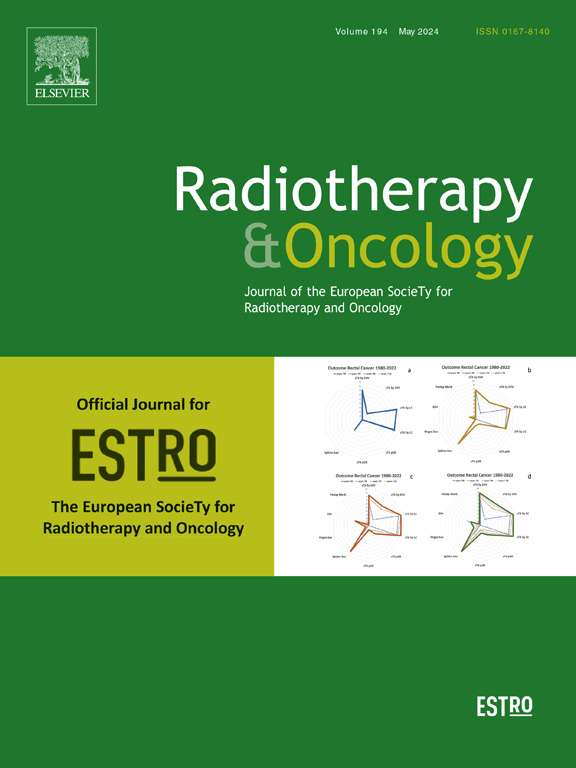食管癌患者接受三联疗法时左心室剂量与急性心脏毒性风险相关
IF 4.9
1区 医学
Q1 ONCOLOGY
引用次数: 0
摘要
背景和目的食管癌(EC)患者接受新辅助放化疗(nCRT)后再进行手术(三段式治疗)有发生心脏毒性的风险(CarTox)。放疗和手术之间的相互作用保证了该人群特定的CarTox预测模型。材料和方法2015年1月至2023年12月期间在鲁汶大学接受光子基nCRT治疗的sec患者符合入选条件。使用标准化成像协议扫描的子集进行基于体素的分析(VBA),比较使用和未使用CarTox的患者的每体素心脏剂量。具有统计学意义的体素与心脏亚结构相匹配。相关的亚结构剂量指标被包括在随后的基于逻辑回归的毒性预测模型中,具有时间开发/验证分裂。最后的外部验证是在MD安德森癌症中心的光子和质子混合治疗队列中进行的。结果:对于VBA, 50例患者被用于识别主要位于左心室(LV)的体素簇,这些体素在发展为CarTox的腺癌患者中剂量较高。随后的模型开发(n = 77)和验证(n = 29)确定了一个包含年龄、接受至少10Gy的左室绝对体积(V10Gy)和相互作用项的模型。用AUC描述的模型性能在验证总体中为0.76。在外部验证(n = 50)中,AUC降至0.66。重新校准后,与推荐的闭环测试程序一致,在校准曲线中观察到良好的LV绝对V10Gy依赖模型性能。基于模型的高危患者识别和最小化他们的低至中lv剂量可能有助于减少接受三段式治疗的ec患者的CarTox。本文章由计算机程序翻译,如有差异,请以英文原文为准。
Dose to the left ventricle is associated to the risk of acute cardiac toxicity in patients with esophageal cancer undergoing trimodality treatment
Background and objective
Esophageal cancer (EC) patients treated with neoadjuvant chemoradiotherapy (nCRT) followed by surgery (trimodality treatment) are at risk for developing cardiac toxicity (CarTox). The interaction between radiotherapy and surgery warrants specific CarTox prediction models in this population.
Materials and methods
EC-patients treated with photon-based nCRT at UZ Leuven between 01–2015 and 12–2023 were eligible for inclusion. A subset scanned with a standardized imaging protocol was used to perform voxel-based analysis (VBA) comparing per-voxel dose to the heart between patients with versus without CarTox. Statistically significant voxels were matched with cardiac substructures. Relevant substructure dose metrics were included in subsequent logistic regression-based toxicity prediction modelling, with a temporal development/validation split. Final external validation was performed on a mixed photon and proton-treated cohort of MD Anderson Cancer Center.
Results
For VBA, 50 patients were used to identify a cluster of voxels located mainly in the left ventricle (LV) that was higher dosed in patients with adenocarcinoma who developed CarTox. Subsequent model development (n = 77) and validation (n = 29) identified a model containing age, the absolute volume of the LV that received at least 10 Gy (V10Gy) and the interaction term. Model performance, depicted by AUC, was 0.76 in the validation population. In external validation (n = 50) AUC reduced to 0.66. After recalibration, in agreement with recommended closed-loop testing procedure, good LV absolute V10Gy dependent model performance was observed in the calibration curve.
Discussion
Model-based identification of high-risk patients and minimizing their low to intermediate LV-dose may help reduce CarTox in EC-patients undergoing trimodality treatment.
求助全文
通过发布文献求助,成功后即可免费获取论文全文。
去求助
来源期刊

Radiotherapy and Oncology
医学-核医学
CiteScore
10.30
自引率
10.50%
发文量
2445
审稿时长
45 days
期刊介绍:
Radiotherapy and Oncology publishes papers describing original research as well as review articles. It covers areas of interest relating to radiation oncology. This includes: clinical radiotherapy, combined modality treatment, translational studies, epidemiological outcomes, imaging, dosimetry, and radiation therapy planning, experimental work in radiobiology, chemobiology, hyperthermia and tumour biology, as well as data science in radiation oncology and physics aspects relevant to oncology.Papers on more general aspects of interest to the radiation oncologist including chemotherapy, surgery and immunology are also published.
 求助内容:
求助内容: 应助结果提醒方式:
应助结果提醒方式:


